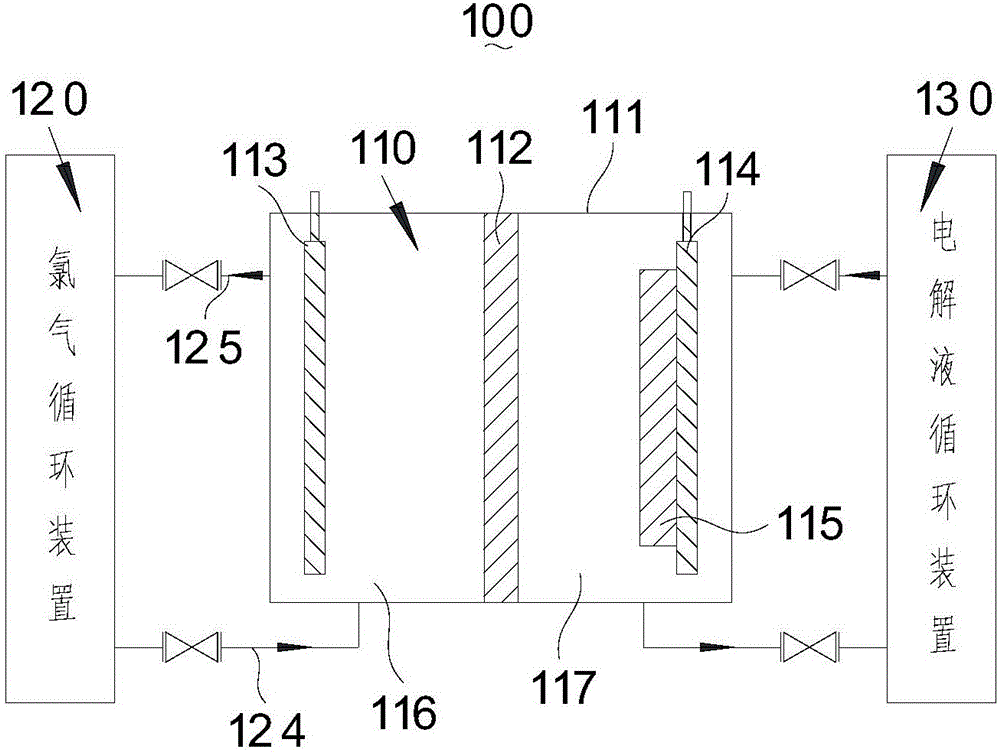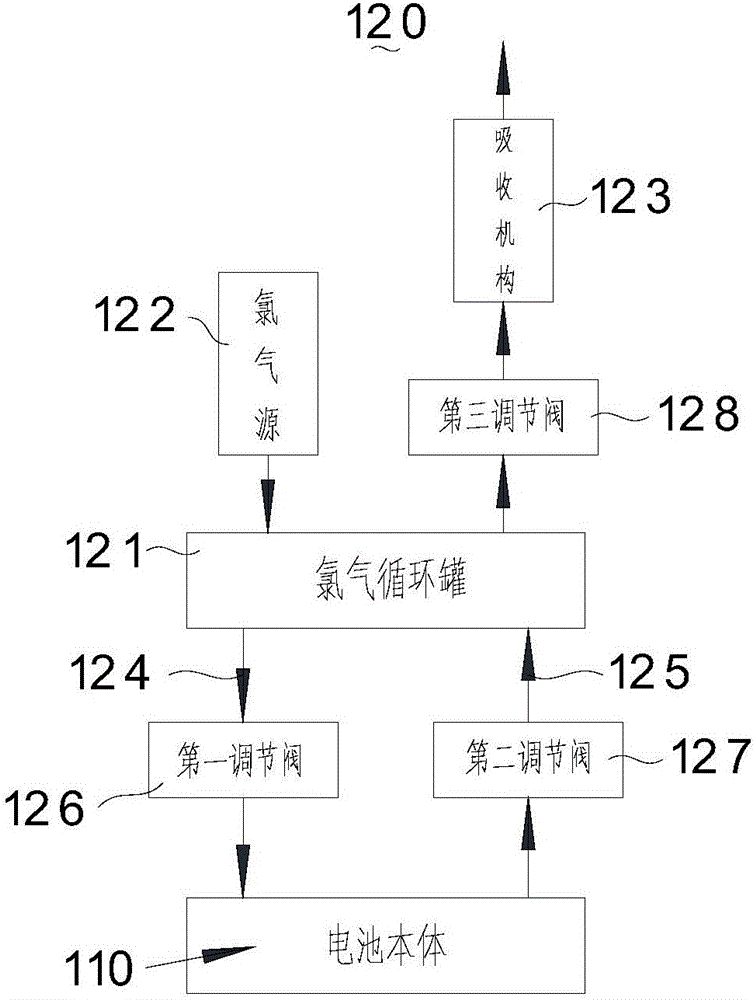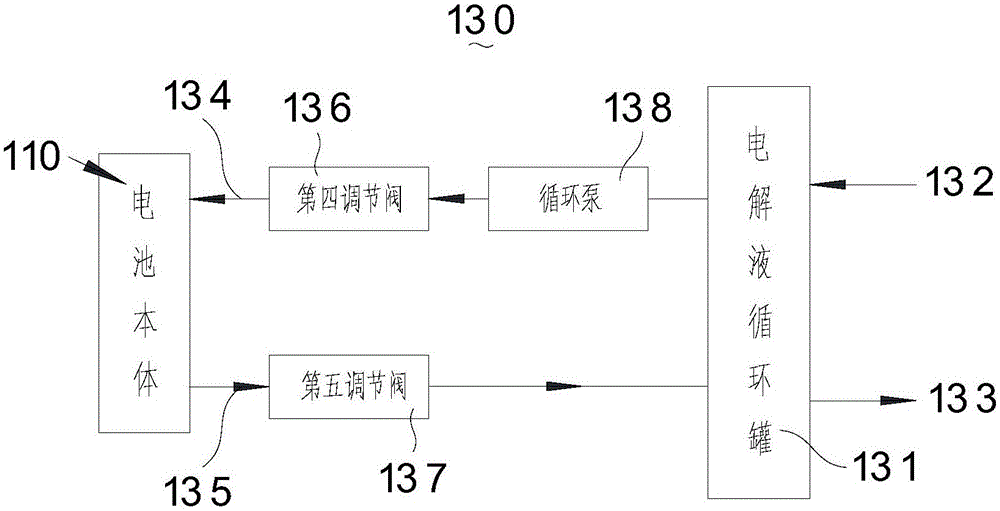Lithium-chlorine battery and energy storage method thereof
A technology of lithium battery and battery body, applied in the field of lithium chloride battery and its energy storage, can solve problems such as the imbalance of power supply and demand, achieve significant economic and social benefits, improve power grid economy, and stabilize energy storage.
- Summary
- Abstract
- Description
- Claims
- Application Information
AI Technical Summary
Problems solved by technology
Method used
Image
Examples
Embodiment 1
[0052] Electrolyte preparation: Mix LiCl, ethylene carbonate and fluorodinitrile evenly to prepare an electrolyte.
[0053] Preparation of the negative electrode plate 114 : the negative electrode plate 114 was obtained by rolling the copper foil.
[0054] Assembling the lithium-chlorine battery 100 : the graphite electrode is used as the positive plate 113 , the negative plate 114 prepared in the above steps and the membrane module 112 are packaged in the casing 111 and assembled into the battery body 110 . In an inert gas environment, electrolyte solution is injected into the battery body 110 and sealed. The assembled battery bodies 110 are connected in series and installed in the battery container, and the positive electrode area 116 of each battery body 110 is communicated with the chlorine gas circulation device 120 . The negative electrode region 117 of each battery body 110 is communicated with the electrolyte circulation device 130 .
[0055] The chlorine-lithium bat...
Embodiment 2
[0057] Electrolyte preparation: LiCl, LiPF 6 、LiBF 4 , diethyl carbonate, ethyl methyl carbonate and 2-methyl-tetrahydrofuran were mixed uniformly to prepare an electrolyte solution.
[0058] Preparation of the negative electrode plate 114: the negative electrode plate 114 is obtained by cold pressing and rolling iron and aluminum.
[0059] Assembling the lithium-chlorine battery 100 : the platinum electrode is used as the positive plate 113 , the negative plate 114 prepared in the above steps and the membrane assembly 112 are packaged in the casing 111 and assembled into the battery body 110 . In an inert gas environment, electrolyte solution is injected into the battery body 110 and sealed. The assembled battery bodies 110 are connected in series and installed in the battery container, and the positive electrode area 116 of each battery body 110 is communicated with the chlorine gas circulation device 120 . The negative electrode region 117 of each battery body 110 is com...
Embodiment 3
[0062] Electrolyte preparation: LiCl, LiClO 4 , Li(CF 3 CO 2 ) 2 N, Li(CF 3 SO 2 ) 2 N, Li(C 2 f 5 SO 2 ) 2 N, LiB(C 2 o 4 ) 2 , propylene carbonate, butylene carbonate, dimethyl carbonate, diethyl carbonate, γ-butyrolactone and dimethoxymethane are mixed uniformly to make an electrolyte.
[0063] Preparation of the negative electrode plate 114 : the negative electrode plate 114 is obtained by cold pressing and rolling of copper and aluminum.
[0064] Assembling the lithium-chlorine battery 100 : the platinum electrode is used as the positive plate 113 , the negative plate 114 prepared in the above steps and the membrane assembly 112 are packaged in the casing 111 and assembled into the battery body 110 . In an inert gas environment, electrolyte solution is injected into the battery body 110 and sealed. The assembled battery bodies 110 are connected in series and installed in the battery container, and the positive electrode area 116 of each battery body 110 is c...
PUM
 Login to View More
Login to View More Abstract
Description
Claims
Application Information
 Login to View More
Login to View More - R&D
- Intellectual Property
- Life Sciences
- Materials
- Tech Scout
- Unparalleled Data Quality
- Higher Quality Content
- 60% Fewer Hallucinations
Browse by: Latest US Patents, China's latest patents, Technical Efficacy Thesaurus, Application Domain, Technology Topic, Popular Technical Reports.
© 2025 PatSnap. All rights reserved.Legal|Privacy policy|Modern Slavery Act Transparency Statement|Sitemap|About US| Contact US: help@patsnap.com



